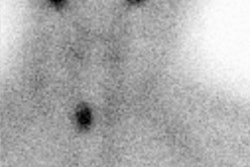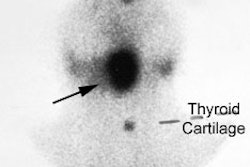J Nucl Med 1996 Jan;37(1):26-31
Radioiodine breast uptake in nonbreastfeeding women: clinical and
scintigraphic characteristics.
Hammami MM, Bakheet S.
We studied the scintigraphic and associated clinical characteristics of
radioiodine breast uptake in nonbreastfeeding thyroid cancer patients undergoing
routine whole-body radioiodine scanning. METHODS: We performed a retrospective
review of the radioiodine scans and medical records of 30 prospectively
collected cases. RESULTS: Twenty-three nonpregnant patients had discontinued
breastfeeding for a mean of 11.4 mo. Three postmenopausal and four single
nulliparous patients had radioiodine breast uptake on one or more occasions.
This represented about 6% of all female patients who had radioiodine scans over
a 3-yr period. Four patterns of uptake, full, focal, crescentic and irregular,
were observed. Breast uptake mimicked lung metastasis in nine patients.
Expressible galactorrhea and moderately elevated prolactin levels were present
in 48% and 24%, respectively, of patients examined. In 14 patients followed for
an average of 11.4 mo, there were no consistent changes in the pattern or
intensity of breast uptake. In 18 patients who had both 123I diagnostic and 131I
postablation scans within a few days, breast uptake was present on both scans in
75%. In four patients, breast uptake was present, despite the 4%-9% radioiodine
uptake by the thyroid; in one patient, iodinated contrast material blocked the
uptake of the thyroid gland but not of the breast. CONCLUSION: Although the
mechanisms of radioiodine breast uptake remain unclear, breast uptake should be
suspected in all female patients with radioiodine uptake in the chest area, even
in the absence of a history of breastfeeding.




